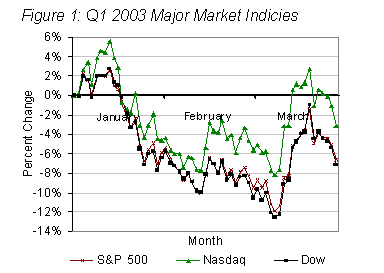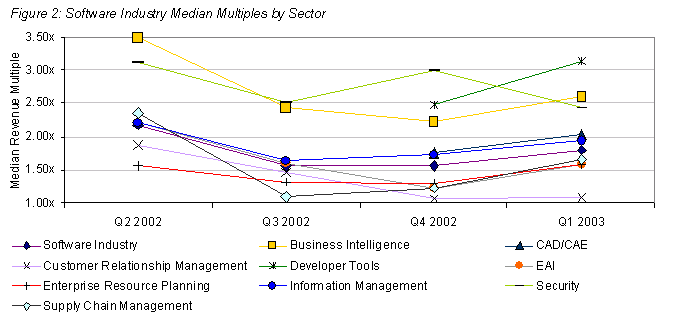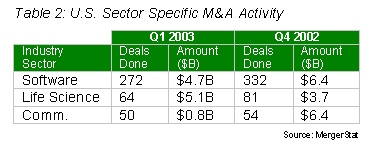|
|
| Home - Software M&A Review - Apr 03 Issue |
Software M&A - Q1 in Review |
By Ken Bender & Allen Cinzori, Software Equity Group
Contrary to the overall economy, the software industry showed some encouraging signs over the quarter. For the first time since we began tracking the SEG-SEVENTY, our software industry public company index, the index recorded positive growth. However, M&A activity, which strongly correlates with the economic environment, faced its share of challenges during the quarter, slowing considerably as world affairs put many buyers and sellers on a temporary holding pattern.
Among the various industry groups, software continues to be M&A’s crown jewel, and buyers continue to seek small and midcap companies with strong financials, technology/market leadership, solid customer bases and product assortments that the buyer can leverage to obtain immediate incremental revenue and earnings.
Moving into Q2, we continue to forecast a 10% increase in software M&A for the year, as U.S. economic growth, increased competitive pressure and the Software Fortune 50’s growing interest in the midmarket serve as catalysts.
ECONOMY
The overall U.S. economy remained lackluster for much of the first quarter, “frozen” by the beating drums of war. Public markets, which showed promise at the start of the quarter, were 15% off their peak by mid-March as uneasy investors reacted to increased geopolitical uncertainty (see Figure 1). By quarter-end, the Nasdaq, Dow and S&P 500 were down 3.0%, 7.1% and 6.7%, but remained above October’s lows.

Underlying the market indices, major economic indicators illustrated some of the challenges present in the U.S. economy. Gross domestic product (GDP), the speedometer for the U.S. economy, decelerated slightly from the 2.4% pace it set in 2002 to approximately 1.7%, as rising energy prices, sluggish business expenditures and flat retail sales took their toll. Businesses and consumers cited geopolitical uncertainty as a major factor for their subdued spending. Unemployment remained relatively flat, ending the quarter at 5.8%.
Looking forward, many analysts are conservatively optimistic, forecasting 2.1% GDP growth in Q2 and 3.7% during the second half of the year. Recent economic releases from the consumer sector, which accounts for roughly 2/3rds of U.S. GDP, support their outlook. Retail sales jumped 2.1% in March, the biggest gain in seventeen months, and Consumer Sentiment faired very well late in the quarter, largely due to the coalition’s successes. The Central Bank continues to insist that growth will pick up upon resolution of events in Iraq.
Somewhat surprisingly, the software industry showed some very encouraging signs over the quarter (see Figure 2). For the first time since we began tracking the SEG-SEVENTY, our software industry public company index, the index recorded positive growth, adding 16% to its Q4 2002 market value. The index’s median revenue multiple increased 15% to 1.8x and the median earnings multiple grew 10.2% to 34.2x. Median revenue multiples for each sector were:
Business Intelligence (BI), 2.6xCAD/CAE, 2.0xCustomer Relationship Management (CRM), 1.1xDeveloper Tools (DT), 3.1xEnterprise Application Integration (EAI), 1.6x Enterprise Resource Planning (ERP), 1.6xInformation / Data Management (IM), 1.9xSecurity, 2.4xSupply Chain Management (SCM), 1.7x

The first quarter also reinforced a trend highlighted in our Q3 2002 Report – the larger and/or more profitable the public software company, the higher the valuation as a multiple of revenue (see Table 1).

MERGERS & ACQUISITIONS
M&A activity, which strongly correlates with the current economic climate, slowed considerably in the quarter, as world affairs placed most buyers and sellers in a holding pattern (see Figure 3). Relative to the fourth quarter, the number of transactions fell 21% and aggregate dollar value declined by 25%. Should the economy continue at the current rate, 6,244 deals would close at an aggregated $290B in 2003.

Among the various industry groups, software M&A continues to lead all other sectors. Software accounted for 272 deals, approximately 17% of U.S. M&A activity (see Table 2). Software buyers continue to seek small and midcap companies with strong financials, technology/market leadership, solid customer bases and product assortments which the buyer can leverage to obtain immediate incremental revenue and earnings.
|
|


|

